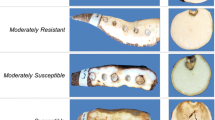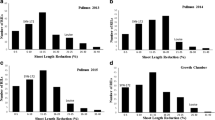Abstract
Spongospora subteranea, the causal agent of potato powdery scab is becoming increasingly important worldwide. Little is known about the genetic basis of resistance to this disease. The present study tested the hypothesis that potato genotypes with stable genetic resistance to “Spongospora root galling” were present in potato germplasm. Root galling index values of 24 genotypes screened for resistance in four field trials (environments) in 2004 and 2005 in Washington State and Idaho were analyzed. Genotypes tested included five resistant, four industry standards and advanced selections from the USDA-ARS, Prosser, WA program. Broad-sense heritability was calculated as 0.76 with a 95% confidence interval of 0.55–0.89, indicating a fairly high genetic component of the trait. Of the 24 genotypes that were tested, eight showed no genotype*environment interactions while six of the remainder had significant variance (i.e., they were unstable) after removal of genotype*environment variance. Among the five resistant genotypes, PA95B2-4 was stable, and PA98N5-2, PA98NM38-1, PO94A009-7 and POR00HG5-1 were stable after the removal of environmental heterogeneity. Among the four industry standards, Shepody was unstable, whereas Ranger Russet, Russet Burbank and Umatilla Russet were stable after the removal of genotype*environment variance. Stable resistance to “Spongospora root galling” was identified. A large portion of the variation was genetic, which will enable breeders to use resistant and stable potato genotypes as parents in future breeding to develop superior commercial potato cultivars with resistance to “Spongospora root galling”.
Resumen
Spongospora subteranea, el agente causal de la roña polvorienta se está convirtiendo de importancia en aumento en el mundo. Se sabe poco de las bases genéticas de la resistencia a esta enfermedad. El presente estudio probó la hipótesis de que los genotipos de papa con resistencia genética estable al “agallamiento radical por Spongospora” estaban presentes en germoplasma de papa. Se analizaron los valores del índice de agallamiento radical de 24 genotipos probados para resistencia en cuatro ensayos de campo (ambientes) en 2004 y 2005 en los Estados de Washington y Idaho. Los genotipos probados incluyeron cinco resistentes, cuatro estándares para la industria y selecciones avanzadas del programa USDA-ARS, Prosser, WA. Se calculó la heredabilidad en una base amplia como 0.76 con un intervalo de confianza de 95% de 0.55 a 0.89, indicando justamente un componente genético amplio del carácter. De los 24 genotipos probados, ocho no mostraron interacción genotipo-medio ambiente, mientras que seis del resto tuvieron varianza significativa (por ejemplo, fueron inestables) después de eliminar la varianza genotipo ambiente. Entre los cinco genotipos resistentes, PA95B2-4 fue estable, y PA98N5-2, PA98NM38-1, PO94A009-7 y POR00HG5-1 fueron estables después de eliminar la heterogeneidad del ambiente. Entre los cuatro genotipos estándares para la industria, Shepody fue inestable, mientras que Ranger Russet, Russet Burbank y Umatilla Russet fueron estables después de eliminar la varianza genotipo-ambiente. Se identificó resistencia estable a “agallamiento radical por Spongospora”. Una gran proporción de la variación fue genética, lo cual permitirá a los mejoradores usar genotipos resistentes y estables de papa como progenitores en mejoramiento futuro para desarrollar cultivares comerciales de papa superiores con resistencia al “agallamiento radical por Spongospora”.
Similar content being viewed by others
References
Alexopoulos, C.J., C.W. Mims, and M. Blackwell. 1996. Phylum Plasmodiophoromycota. Endoparasitic slime molds. In Introductory Mycology, 4th ed. 751–758. John Wiley & Sons, Inc.
Braselton, J.P. 2001. Plasmodiophoromycota. In The Mycota VII Part A. Systematics and evolution, ed. D.J. McLaughlin, E.G. Mclaighin, and P.A. Lemke, 81–91. Berlin & Heildelberg: Springer-Verlag.
Brown, C.R., H. Mojtahedi, S. James, R.G. Novy, and S. Love. 2006. Development and evaluation of potato breeding lines with introgressed resistance to Columbia root-knot nematode (Meloidogyne chitwoodi). American Journal of Potato Research 83: 1–8.
Brown, C.R., G. Vandemark, D. Johnson, T. Cummings, D. Batchelor, J. Miller, and C. Olsen. 2007. Resistance to powdery scab in potato. Potato Progress 7 (6): 1. Published by the Washington State Potato Commission, www.potatoes.com.
Cavalier-Smith, T. 2003. Protist phylogeny and the high-level classification of Protozoa. European Journal of Protistology 39: 338–348.
Falloon, R.E., L.H. Viljanen-Rollinson, G.D. Coles, and J.D. Poff. 1995. Disease severity keys for powdery and downy mildews of pea, and powdery scab of potato. New Zealand Journal of Crop and Horticultural Sciences 23: 31–37.
Falloon, R.E., A.R. Wallace, M. Braithwaite, R.A. Genet, H.M. Nott, J.D. Fletcher, and W.F. Braam. 1996. Assessment of seed tuber, in-furrow, and foliar chemical treatments for control of powdery scab (Spongospora subterranea f.sp. subterranea) of potato. New Zealand Journal of Crop and Horticultural Sciences 24: 341–353.
Harrison, J.G., R.J. Searle, and N.A. Williams. 1997. Powdery scab of potato—a review. Plant Pathology 46: 1–25.
Haynes, K.G., R.W. Goth, and R.J. Young. 1997. Genotype x environment interactions for resistance to common scab in tetrapioid potato. Crop Science 37: 1163–1167.
Johnson, D.A., and T.F. Cummings. 2004. Powdery scab: Is there a hope for economic control? Pages 25–26. In Proceedings of the 43 rd Washington State annual potato conference. Published by the Washington State Potato Commission, www.potatoes.com.
Jones, R.A.C., and B.D. Harrison. 1969. The behaviour of potato mop top virus in soil, and evidence for its transmission by Spongospora subterranea (Wallr.) Lagerh. Annals of Applied Biology 63: 1–17.
Kang, M.S. 1989. A new SAS program for calculating stability-variance parameters. Journal of Heredity 80: 415.
Knapp, S.J., W.W. Stroup, and W.M. Ross. 1985. Exact confidence intervals for heritability on a progeny mean basis. Crop Science 25: 192–194.
Kole, A.P. 1954. A contribution to the knowledge of Spongospora subterranea (Wallr.) Legerh., the cause of powdery scab of potatoes. Tijdschr Planten 60: 1–65.
Love, S.L., R.G. Novy, J.L. Whitworth, D.L. Corsini, J.J. Pavek, A.R. Mosley, R.E. Thornton, N.R. Knowles, S.R. James, and D.C. Hane. 2005. Summit russet: a new russet potato variety with good fresh market and frozen processing qualities. American Journal of Potato Research 82: 425–432.
Merz, U. 2000. Powdery scab. Research in Switzerland. Pages 67–71. In Proceedings of the first European Powdery Scab workshop, ed. Merz, U., Lees, A.K. SAC, Aberdeen, Scotland. ISBN 09-0587-516-8
Merz, U. 2008. Powdery scab of potato—occurrence, life cycle and epidemiology. American Journal of Potato Research 85: 241–246.
Merz, U., and R.E. Falloon. 2009. Review: powdery scab of potato—increased knowledge of pathogen biology and epidemiology for effective disease management. Potato Research 52: 17–37.
Merz, U., V. Martinez, and R. Schwarzel. 2004. The potential for the rapid screening of potato cultivars (Solanum tuberosum) for resistance to powdery scab (Spongospora subterranea) using a laboratory bioassay. European Journal of Plant Pathology 110: 71–77.
Nitzan, N., T.F. Cummings, D.A. Johnson, J.S. Miller, D.L. Batchelor, C. Olsen, R.A. Quick, and C.R. Brown. 2008. Resistance to root galling caused by the powdery scab pathogen Spongospora subterranea in potato. Plant Disease 92: 1643–1649.
Nitzan, N., M.A. Evans, T.F. Cummings, D.A. Johnson, D.L. Batchelor, C. Olsen, K.G. Haynes, and C.R. Brown. 2009. Field resistance to potato stem colonization by the black dot pathogen Colletotrichum coccodes. Plant Disease 93: 1116–1122.
Qu, X.S., and B.J. Christ. 2006. Single cystosorus isolate production and restriction fragment length polymorphism characterization of the obligate biotroph Spongospora subterranea f. sp. subterranea. Phytopathology 96: 1157–1163.
Schreiber, A. 2006. Potato tuber-worm: a potential new pest of potato in Washington’s storages. Potato Progress 6 (13): 3. Published by the Washington State Potato Commission, www.potatoes.com.
Shukla, G.K. 1972. Some statistical aspects of partitioning genotype-environment components of variability. Heredity 29: 237–245.
Van de Graaf, P., S.J. Wale, and A.K. Lees. 2007. Factors affecting the incidence and severity of Spongospora subterranea infection and galling in potato roots. Plant Pathology 56: 1005–1013.
Acknowledgments
This research was supported by the Washington State Potato Commission and USDA/ARS, Prosser, WA.
Author information
Authors and Affiliations
Corresponding author
Rights and permissions
About this article
Cite this article
Nitzan, N., Haynes, K.G., Miller, J.S. et al. Genetic Stability in Potato Germplasm for Resistance to Root Galling Caused by the Pathogen Spongospora subterranea . Am. J. Pot Res 87, 497–501 (2010). https://doi.org/10.1007/s12230-010-9152-5
Published:
Issue Date:
DOI: https://doi.org/10.1007/s12230-010-9152-5




